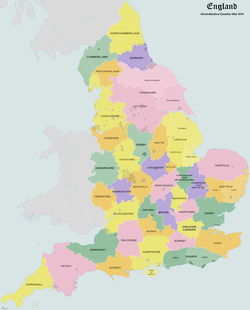Administrative counties of England
| Administrative county (England) | |
|---|---|
 |
|
| Category | Administrative county |
| Location | England |
| Found in | County |
| Created by | Local Government Act 1888 |
| Created | 1889 |
| Abolished by | Local Government Act 1972 |
| Abolished | 1974 |
| Populations | 25,000–4.2 million |
| Government | County council |
| Subdivisions |
Rural district Urban district Municipal borough |
Administrative counties were a level of subnational division of England used for the purposes of local government from 1889 to 1974. They were created by the Local Government Act 1888 as the areas for which county councils were elected. Some large counties were divided into several administrative counties, each with its own county council. The administrative counties were abolished by the Local Government Act 1972 and were replaced by the metropolitan and non-metropolitan counties of England.
The administrative counties did not exist prior to 1889, see historic counties of England for the history of the English counties before then.
In 1888 the government, led by the Tory prime minister Lord Salisbury established county councils throughout England and Wales, covering areas known as administrative counties. Many larger towns and cities were given the status of county borough, with similar powers and independent of county council control. Under the Act, each county borough was an "administrative county of itself".
Cambridgeshire, Lincolnshire, Northamptonshire, Suffolk, Sussex, and Yorkshire were split up for administrative purposes, following historical divisions used by the Courts of Quarter Sessions.
Additionally there was a County of London which covered the area today known as Inner London. The Isle of Wight was originally included under the administrative county of Hampshire but obtained its own county council in 1890.
...
Wikipedia
